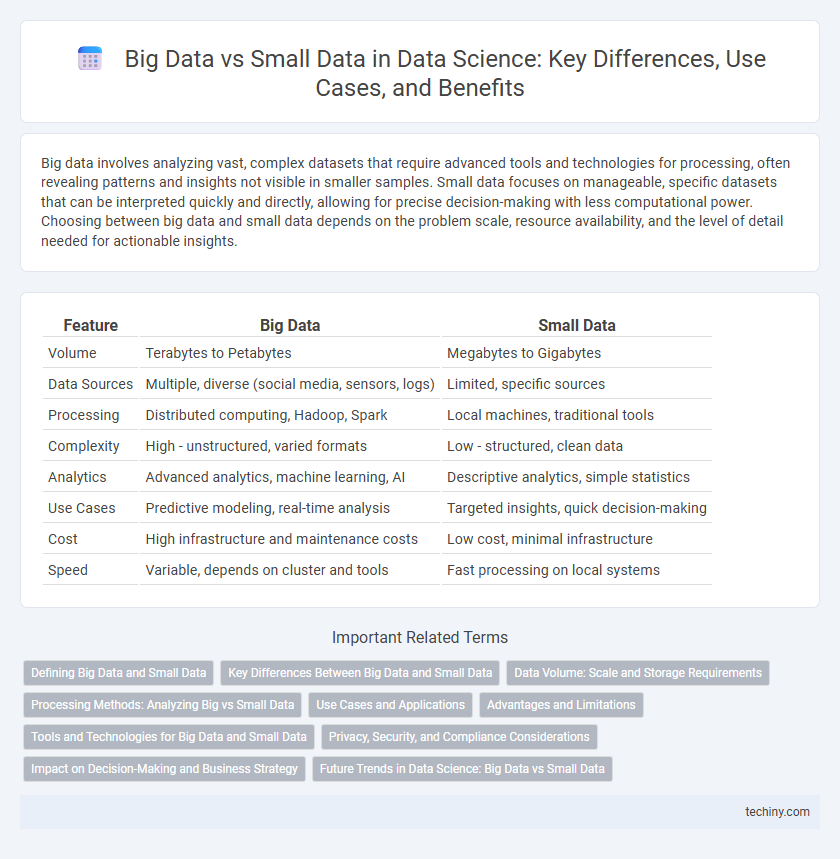Big data involves analyzing vast, complex datasets that require advanced tools and technologies for processing, often revealing patterns and insights not visible in smaller samples. Small data focuses on manageable, specific datasets that can be interpreted quickly and directly, allowing for precise decision-making with less computational power. Choosing between big data and small data depends on the problem scale, resource availability, and the level of detail needed for actionable insights.
Table of Comparison
| Feature | Big Data | Small Data |
|---|---|---|
| Volume | Terabytes to Petabytes | Megabytes to Gigabytes |
| Data Sources | Multiple, diverse (social media, sensors, logs) | Limited, specific sources |
| Processing | Distributed computing, Hadoop, Spark | Local machines, traditional tools |
| Complexity | High - unstructured, varied formats | Low - structured, clean data |
| Analytics | Advanced analytics, machine learning, AI | Descriptive analytics, simple statistics |
| Use Cases | Predictive modeling, real-time analysis | Targeted insights, quick decision-making |
| Cost | High infrastructure and maintenance costs | Low cost, minimal infrastructure |
| Speed | Variable, depends on cluster and tools | Fast processing on local systems |
Defining Big Data and Small Data
Big Data refers to vast volumes of structured and unstructured data characterized by the three Vs: volume, velocity, and variety, requiring advanced analytics and storage solutions. Small Data consists of manageable, well-defined datasets that are easily accessible and analyzed with traditional tools, focusing on specific insights with minimal complexity. Defining these types depends on scope, processing requirements, and use cases within data science applications.
Key Differences Between Big Data and Small Data
Big data involves vast volumes of diverse, high-velocity datasets requiring advanced distributed processing frameworks like Hadoop and Spark, whereas small data consists of manageable datasets that can be analyzed using traditional database tools and statistical methods. Big data's complexity demands specialized storage, real-time analytics, and machine learning algorithms, while small data allows for quicker, more straightforward insights with limited computational resources. The key difference lies in scale, processing techniques, and the complexity of data variety and velocity impacting decision-making strategies.
Data Volume: Scale and Storage Requirements
Big data involves massive volumes of structured and unstructured data, often measured in petabytes or exabytes, requiring distributed storage systems like Hadoop and cloud-based architectures to efficiently manage scale and accessibility. Small data, typically ranging from kilobytes to gigabytes, can be stored and processed on local devices or simple databases, emphasizing quick analysis and ease of handling. The scalable infrastructure and high storage capacity of big data platforms support complex analytics and machine learning, while small data suits targeted, domain-specific insights with lower resource demands.
Processing Methods: Analyzing Big vs Small Data
Big data processing methods leverage distributed computing frameworks like Hadoop and Spark to handle petabytes of structured and unstructured information, enabling real-time analytics and complex machine learning models. Small data analysis uses traditional statistical software such as R or Excel, focusing on detailed, high-quality datasets typically requiring less computational power and easier interpretability. The choice of processing method impacts speed, scalability, and the type of insights generated in data science projects.
Use Cases and Applications
Big data enables complex analytics across vast datasets for applications like predictive maintenance, fraud detection, and personalized marketing, offering insights that drive strategic decision-making in industries such as finance, healthcare, and retail. Small data focuses on manageable, context-rich datasets suitable for targeted market research, customer feedback analysis, and operational improvements in small businesses or specific departments. Choosing between big data and small data depends on factors like data volume, processing capabilities, and the precision required for actionable insights in use cases.
Advantages and Limitations
Big data provides the advantage of extensive datasets that enable more accurate predictive analytics and uncover hidden patterns through machine learning algorithms, but it requires significant computational power and complex data management. Small data offers easier handling and faster analysis, making it suitable for quick decision-making and specific problem-solving, yet it may lack the depth and scalability needed for comprehensive insights. Both data types have limitations related to data quality, storage costs, and analytical capabilities depending on the scope and objectives of data science projects.
Tools and Technologies for Big Data and Small Data
Big data tools and technologies such as Apache Hadoop, Spark, and NoSQL databases enable the processing of vast, complex datasets through distributed computing and real-time analytics. Small data often relies on traditional tools like Excel, SQL databases, and Python libraries (pandas, scikit-learn) for manageable, structured datasets that require quick, precise analysis. The choice between these technologies depends on data volume, velocity, and variety, optimizing efficiency and insights for specific analytical needs.
Privacy, Security, and Compliance Considerations
Big data environments require robust privacy frameworks, as the volume and variety of data increase the risk of unauthorized access and breaches. Small data, while more manageable, still demands strict compliance with regulations like GDPR and HIPAA to protect sensitive information. Ensuring data security in both contexts involves encryption, access controls, and continuous monitoring to mitigate vulnerabilities and safeguard user privacy.
Impact on Decision-Making and Business Strategy
Big data enables organizations to analyze vast, diverse datasets in real-time, uncovering complex patterns and trends that drive predictive analytics and more informed decision-making. Small data, while limited in volume, offers higher accuracy and relevance for niche markets, allowing businesses to tailor strategies with precision and agility. Integrating both big and small data approaches enhances overall business strategy by balancing breadth of insight with focused, actionable intelligence.
Future Trends in Data Science: Big Data vs Small Data
Future trends in data science indicate a growing emphasis on integrating big data and small data analytics to optimize decision-making processes. Advanced machine learning algorithms and edge computing are enabling real-time processing of small data sets while leveraging the vast insights from big data repositories. This hybrid approach enhances predictive accuracy, operational efficiency, and personalized user experiences across industries.
big data vs small data Infographic

 techiny.com
techiny.com